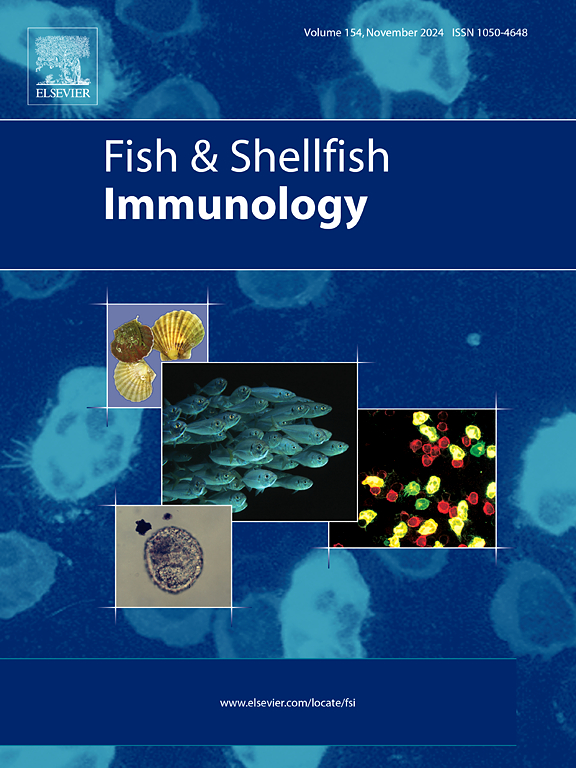Influence of Vibrio anguillarum culture conditions on the efficacy of bacterin-based vaccines in lumpfish (Cyclopterus lumpus)
IF 4.1
2区 农林科学
Q1 FISHERIES
引用次数: 0
Abstract
Lumpfish (Cyclopterus lumpus) is used as cleaner fish to control sea lice infestations in Atlantic salmon (Salmo salar) farms across the North Atlantic. Vibrio anguillarum, the causative agent of vibriosis, is a recurrent bacterial pathogen affecting lumpfish. Bacterin-based vaccines are frequently used to control vibriosis in finfish, but their efficacy is not always consistent. Culture conditions significantly influence synthesis of bacterial outer membrane and secreted proteins, which are critical antigens, and thus impact the immunogenicity of bacterin-based vaccines. In this study, we assessed the effect of V. anguillarum culture conditions on vaccine efficacy in lumpfish. V. anguillarum was cultured under iron-limited at 15 °C, and iron-rich or iron-limited conditions at 28 °C with 2 % NaCl, and these cultures were used to prepare bacterins. A commercial vaccine was used as positive control, while PBS and PBS adjuvant were negative controls. Lumpfish were intraperitoneally immunized and challenged 12 weeks post-immunization with 10–100 times the LD50 dose of V. anguillarum. Bacterins prepared from V. anguillarum grown under iron-limited conditions at 28 °C with 2 % NaCl and mixed with adjuvant conferred the highest protection compared to other preparations and commercial vaccines. In contrast, bacterins derived from V. anguillarum cultured under iron-limited conditions at 15 °C conferred the lowest protection. Reverse vaccinology and transcriptomic analyses of V. anguillarum grown under optimal immunogenic conditions revealed 323 upregulated genes, of which 211 were high-antigenicity proteins suitable for subunit vaccines. This study provides critical knowledge for effective vaccine formulation against V. anguillarum and identifies potential antigens for subunit vaccine development.
在北大西洋的大西洋鲑鱼(Salmo salar)养殖场中,鳞鱼(Cyclopterus lumpus)被用作控制海虱侵扰的清洁鱼。弧菌病的致病菌鳗鲡弧菌是影响鳞鱼的一种经常性细菌病原体。以细菌素为基础的疫苗常用于控制鱼类的弧菌病,但其效果并不总是一致。培养条件会极大地影响细菌外膜蛋白和分泌蛋白的合成,而这些蛋白是关键的抗原,因此会影响细菌素疫苗的免疫原性。在本研究中,我们评估了鳗鲡培养条件对囫囵鱼疫苗效力的影响。在 15°C 的铁限制条件下培养鳗鲡,在 28°C 的铁丰富或铁限制条件下用 2% NaCl 培养鳗鲡,并用这些培养物制备细菌素。商业疫苗作为阳性对照,PBS 和 PBS 佐剂作为阴性对照。鳗鲡鱼腹腔免疫,并在免疫后 12 周接受 10 至 100 倍 LD50 剂量的鳗鲡鱼挑战。与其他制剂和商业疫苗相比,在28°C、2% NaCl的铁限制条件下生长并与佐剂混合的鳗鲡细菌制备的细菌素具有最高的保护能力。相比之下,在 15°C 铁限制条件下培养的鳗鲡菌产生的细菌素所提供的保护性最低。对在最佳免疫原性条件下生长的鳗鲡进行反向疫苗学和转录组分析,发现了 323 个上调基因,其中 211 个是适合亚单位疫苗的高抗原性蛋白。这项研究为有效配制鳗鲡疫苗提供了重要知识,并为亚单位疫苗的开发确定了潜在的抗原。
本文章由计算机程序翻译,如有差异,请以英文原文为准。
求助全文
约1分钟内获得全文
求助全文
来源期刊

Fish & shellfish immunology
农林科学-海洋与淡水生物学
CiteScore
7.50
自引率
19.10%
发文量
750
审稿时长
68 days
期刊介绍:
Fish and Shellfish Immunology rapidly publishes high-quality, peer-refereed contributions in the expanding fields of fish and shellfish immunology. It presents studies on the basic mechanisms of both the specific and non-specific defense systems, the cells, tissues, and humoral factors involved, their dependence on environmental and intrinsic factors, response to pathogens, response to vaccination, and applied studies on the development of specific vaccines for use in the aquaculture industry.
 求助内容:
求助内容: 应助结果提醒方式:
应助结果提醒方式:


